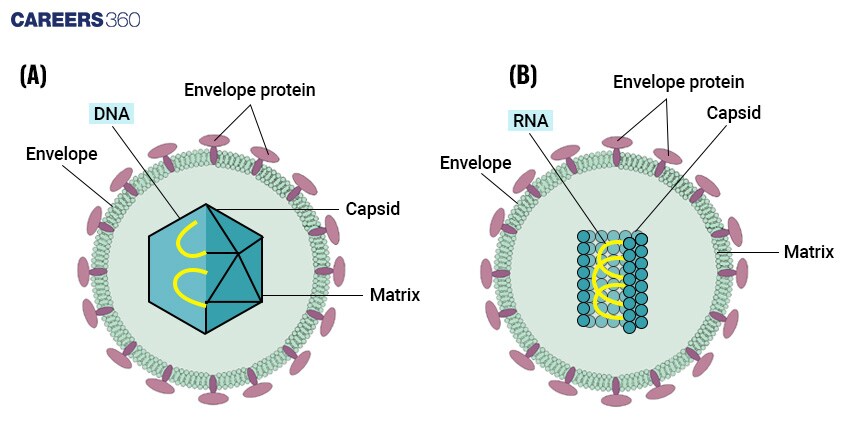Difference between DNA and RNA Viruses: Key Differences and Comparison
DNA viruses contain DNA as their genetic material, which is typically more stable and replicates in the host cell's nucleus. In contrast, RNA viruses have RNA as their genetic material, which is usually less stable and often replicates in the host cell's cytoplasm. DNA viruses contain DNA as their genetic material. Examples include herpesviruses and adenoviruses. RNA viruses use RNA as their genetic material and include viruses like influenza and HIV. On this page, we will learn about the DNA virus and RNA virus, the difference between them, and their pathogenesis, replication, and evolution. DNA and RNA Viruses is a topic of the chapter Biological Classification in Biology.
NEET 2025: Mock Test Series | Syllabus | High Scoring Topics | PYQs
NEET Important PYQ's Subject wise: Physics | Chemistry | Biology
New: Meet Careers360 B.Tech/NEET Experts in your City | Book your Seat now
- DNA and RNA Viruses definition
- RNA Virus vs DNA Virus
- Structure and Composition of Virus
- Genetic Material
- Replication Strategy
- Genetic Variability and Mutation Rate
- Viral Diseases and Pathogenesis
- Diagnosis and Treatment
- Evolutionary Considerations
- Recommended video on Difference between DNA and RNA Viruses

DNA and RNA Viruses definition
These are very minute infection agents that are highly variable in structure and genetic constitution. They have been sub-classified into DNA and RNA viruses based on their genetic material. The differences between DNA and RNA viruses are significant in understanding how viruses replicate and guide targeted treatments, such as antiviral medications or vaccines. This is very vital knowledge in the field of virology due to this and will continue to play a frontline role in the diagnosis, prevention, and control of viral diseases in humans, animals, and plants.
RNA Virus vs DNA Virus
It is one of the important differences and comparison articles in biology. The following summarises the difference between DNA and RNA Virus
Feature | DNA Viruses | RNA Viruses |
Genetic Material | DNA (Deoxyribonucleic Acid) | RNA (Ribonucleic Acid) |
Stability | More stable, less prone to mutations | Less stable, more prone to mutations |
Replication Site | Nucleus (mostly) | Cytoplasm (mostly) |
Examples | Herpesvirus, Adenovirus, Poxvirus | Influenza virus, HIV, SARS-CoV-2 |
Genome Structure | Mostly double-stranded, can be single-stranded | Mostly single-stranded, can be double-stranded |
Enzyme Requirement | Uses host cell's DNA polymerase for replication | Uses its RNA-dependent RNA polymerase |
Mutagenicity | Lower mutation rates due to proofreading mechanisms | Higher mutation rates due to lack of proofreading |
Integration into Host Genome | Can integrate (e.g., Herpesviruses) | Often integrated (e.g., Retroviruses like HIV) |
Example Diseases | Chickenpox, Smallpox, Hepatitis B | AIDS, COVID-19, Influenza |
Vaccine Development | Generally easier due to stability | More challenging due to high mutation rates |
Also read-
Structure and Composition of Virus
DNA Viruses possess a nucleocapsid comprising a protein coat that envelops the viral DNA genome. The mentioned nucleocapsid may, in turn, be enveloped in an envelope. This includes Herpesviruses, containing large enveloped capsids, and Adenoviruses with their capsid structures being large and non-enveloped icosahedral.
RNA Viruses have a capsid composed of protein subunits called capsomeres that encapsulate either single-stranded or double-stranded RNA. Many RNA viruses also have an envelope derived from the host cell membrane with viral glycoproteins protruding from it that help in recognition and entry into the host cell. Examples include the Influenza virus, and HIV, with an enveloped capsid containing two copies of single-stranded RNA.
Diagram of RNA and DNA virus
The diagram below shows the structure of both DNA and RNA viruses.

Genetic Material
The genetic material of DNA virus is double-stranded DNA. These viruses, in their replication, transcribe DNA into messenger RNA using host cell machinery and replicate their genome by utilising DNA polymerase enzymes. Most DNA viruses conduct most of this replication in the host cell nucleus. This will ensure accuracy in duplication and integration into the host genome in some cases.
RNA Viruses can have either single-stranded RNA or double-stranded RNA as their genetic material. However, for the process of replication, all RNA viruses depend upon the participation of RNA-dependent RNA polymerase (RdRp), an enzyme replicating RNA from an RNA template. RdRp participates primarily in the generation of viral RNA genomes and the production of mRNA for the expression of viral proteins. That usually takes place in the cytoplasm of a host cell, where RNA viruses hijack cellular machinery for their lifestyle cycle.
Replication Strategy
DNA Viruses infection begins by binding to host cell receptors, followed by entry into the cell and causing release of its DNA genome. It undergoes replication in the nucleus with the help of host enzymes. Assembly of viral components takes place, followed by release through the process of cell lysis or budding.
The replication of RNA viruses involves different strategies: positive-sense RNA viruses directly translate their genome in the cell into proteins. Negative-sense RNA viruses first synthesise mRNA with the help of RdRp. Retroviruses—after being converted into DNA—integrate into the host genome and replicate together with the host genome, helped by reverse transcriptase.
Genetic Variability and Mutation Rate
The mutation rate in DNA Viruses is lower because DNA polymerase has the capability to proofread during replication. This stability in genetic material makes the vaccine targets consistent and vaccines developed against viruses like Hepatitis B and HPV remain effective over a long period.
In replication, given the high error rate of RNA Viruses, this is typified by the error-prone RdRp. Such variability means that updated vaccines like the flu have to be reformulated every year to keep vaccine effectiveness against viral populations that are constantly evolving.
Viral Diseases and Pathogenesis
DNA Viruses also cause several diseases, including chickenpox—through Varicella-zoster virus—in humans. Hepatitis B virus presents with chronic infection of liver cells, cirrhosis, and liver cancer.
RNA Viruses are another group of viruses causing a host of diseases, some of which range from very mild to highly life-threatening. COVID-19 is caused by a new coronavirus SARS-CoV-2. It causes pneumonia and acute respiratory distress syndrome.
Diagnosis and Treatment
DNA Viruses are diagnosed by PCR, which is the detection of viral DNA, and serological tests for the detection of antibodies against viral antigens. The treatment includes antiviral drugs—for example, herpesviruses and hepatitis B are susceptible to acyclovir. Vaccines are also used for its prevention, like the hepatitis B vaccine.
RNA Viruses diagnosis is made by RT-PCR for the detection of viral RNA and antigen tests for the identification of the viral protein. Treatment includes antiviral medications like remdesivir for COVID-19 and RNA-based vaccines developed for COVID-19.
Evolutionary Considerations
DNA Viruses often have co-evolved with their host genomes. Such evolutionary trends could be broadly stable over time.
These dynamics of evolutionary change in RNA viruses are very fast because they have a high mutation rate and a wide range of genetic variability.
Also Read-
| Cell Envelope | Five Kingdom Classification |
| Composition of Bacterial Cell Wall | Kingdom Monera, Protista And Fungi |
| Gram Staining | Salient features of the Kingdom Monera |
Recommended video on Difference between DNA and RNA Viruses
Frequently Asked Questions (FAQs)
DNA viruses have double-stranded DNA as their genome, while for RNA viruses the genome makes up single-stranded RNA or double-stranded RNA.
In DNA viruses a capsid surrounds their DNA genome with the frequent addition of an envelope avec derived from the host cell membrane. In RNA viruses, there is a capsid enclosing their RNA genome, and in some cases, the viruses are integrated with envelopes studded with viral proteins.
Herpesviruses (like herpes simplex virus) and adenoviruses are examples of DNA viruses, whereas the influenza virus with negative-sense ssRNA and HIV with positive-sense ssRNA are examples of RNA viruses.
Replication of DNA viruses occurs via their entering into the host cell nucleus, after which they hijack the host cell and use its enzymes to do transcription and replication. In the case of RNA viruses, the replication takes place in the cytoplasm of the host cell. Many times, this step is preceded by RNA-dependent RNA polymerase (RdRp).
Higher mutation rates clarify fast genetic variation and adaptation of RNA viruses, hence its bearing on the evolution of viruses and the efficiency of vaccines and treatments applied. Generally, DNA viruses have lower mutation rates, causing the genomes to be much more stable over some time.
Also Read
30 Nov'24 12:23 PM
28 Nov'24 05:34 PM
25 Nov'24 05:18 PM
23 Nov'24 10:02 AM
22 Nov'24 01:59 PM
21 Nov'24 04:58 PM
16 Nov'24 01:58 PM